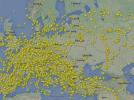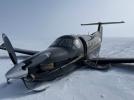Volga Dnepr IL76 at St. John's on Aug 13th 2012, overran runway on landing
The Canadian TSB have released their final report concluding the probable causes of the accident were:
Findings as to Causes and Contributing Factors
- The occurrence aircraft landed with a tail wind that exceeded the aircraft manufacturer’s limitations.
- The combination of the tail wind and the fact that power levers were not reduced to idle until the aircraft was about 2000 feet beyond the threshold resulted in the aircraft landing approximately 4220 feet from the threshold, which reduced the available runway length to stop.
- Excessive tread wear, a wet runway, and existing runway friction values resulted in hydroplaning, which reduced the effective braking capability.
- The incorrect brake line installation reduced the effective braking capability, thereby extending the stopping distance.
- Although the crew used maximum reverse thrust on all 4 engines with 1000 feet of runway remaining, this action was not sufficient to stop the aircraft before the end of the runway.
Findings as to Risk
- Using tires that are more than 80% worn reduces wet runway traction, thereby increasing the risk of hydroplaning and possible runway overruns.
- Not carrying out a runway friction survey in accordance with the International Civil Aviation Organization and the Federal Aviation Administration criteria increases the risk of wet runway hydroplaning because the runway’s overall friction characteristics have not been fully assessed.
- The lack of adequate runway end safety areas (RESA), or other engineered systems designed to stop aircraft that overrun, increases the risk of aircraft damage and passenger injuries.
Other Findings
- The Ilyushin IL-76TD-90VD aircraft maintenance schedule does not identify a minimum tread depth for the main tires when the aircraft operates during the spring-summer season (May to October).
The TSB reported the aircraft approached St. John's at an estimated landing weight of 140 tons, the computed approach speed was 240 kph (130 KIAS), the approach speed was adjusted to 250kph due to reported gusting winds. The crew positioned for an ILS approach to runway 11, intercepted the localizer and glideslope and two minutes later became visual with the runway. The crew received an updated wind report indicating the wind was coming from 260 degrees at 5 knots, meaning a 3 knot tail wind component within permitted limits.
The aircraft crossed the runway threshold at 59 feet and 136 KIAS (252 kph), the pitch angle increased, the power levers were slightly increased for 2 seconds before pulled back to idle reaching idle 8 seconds after crossing the runway threshold. At that time the aircraft was about 2000 feet past the runway threshold at 241 kph (130 KIAS), the aircraft touched down another 7 seconds later at 219 kph (118 KIAS) 3570 feet past the runway threshold, bounced and touched down a second time another 3 seconds later 4220 feet past the runway threshold at 210 kph (113 KIAS).
Maximum reverse was applied on engines #1 and #4, spoilers were deployed, 13 seconds later reverse thrust was briefly reduced before maximum reverse was applied again on #1 and #4 followed by #2 and #3 as well. The aircraft departed the runway surface at 40 KIAS/ 74 kph, maximum reverse was maintained on all 4 engines, the crew steered the aircraft right to avoid the approach lights, the aircraft came to a stop 640 feet past the runway end.
In post flight examination the TSB established that all 16 tyres had been worn to or below the tread wear indicators. 8 main tyres showed evidence of reverted rubber hydroplaning. Inspection of the brakes system revealed, that whenever the antiskid commanded release of brakes pressure to the outboard main wheels, the inboard wheel brakes pressure was released. Similiary, when the inboard brakes pressure was to be released the outboard pressure was released.
The TSB reported that both pilots held valid Russian licenses, the captain had about 11,000 hours total flying experience with 3000 hours on type, the first officer about 7,000 hours with 2,000 hours on type.
Examination of the flight data recorder showed the aircraft had landed with 13 knots tailwind (limit 5 meters/second, about 10 knots). This value had also been displayed to the crew on their multifunction displays, the airline however requires their crew to use the ATIS and air traffic control informations for landing preparations.
The TSB stated that St. John's does not have runway end safety areas (RESA) on runway 11/29, there was also no legal requirement to provide for RESAs. The runways had not been grooved and were not required by regulations to be grooved.
The TSB analysed that the aircraft touched down with just 4282 feet of runway remaining and stated: "After the aircraft crossed the runway threshold, touchdown did not occur in the recommended touchdown area and was delayed due to the crew-induced pitch change. The power levers did not reach idle until the aircraft was approximately 2000 feet beyond the threshold, resulting in a touchdown at 4220 feet. Reverse thrust was reduced when the aircraft was travelling at a speed of 63 knots, which is consistent with the aircraft flight manual instructions. However, at this time, the aircraft was about 1000 feet from the end of the runway. Subsequently, the crew used maximum reverse thrust on all 4 engines. This was not sufficient to stop the aircraft before it reached the end of the runway."
According to the landing weight the crew had computed a landing distance of 4086 feet, 2707 feet of which were actual stopping distance. The TSB stated: "Based on data from the flight data recorder, the TSB determined that the aircraft actually experienced a 13-knot tail wind, which would have required a landing distance of 5184 feet, including a stopping distance of 3608 feet. The 13-knot tail wind would have increased the stopping distance by 901 feet."
The TSB continued: "During the landing roll, the aircraft experienced reverted rubber hydroplaning on 8 of the main tires. Because the hydraulic pressure supply lines were reversed, brake pressure was maintained on the tire that was skidding, but was released to the tires that had effective braking. The incorrect brake line installation reduced the effective braking capability, thereby extending the stopping distance."
http://avherald.com/h?article=454369d6/0000














Komentarze